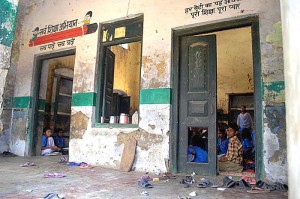According to global education report of 2004, India’s ranking was 106 out of 127 countries in the education sphere
Although India is amongst the ten fastest growing economies in the world, India has the largest number of illiterates by far -close to 40%. .Sixty years after independence, possibly the greatest challenge India faces now is the failure to educate its citizens, notably the poor.
Education is believed to be the only means for a developing nation like India to develop widely and hence the RTE (Right To Education) Act was implemented in the year 2009 enforcing free and compulsory education to all children between 6 to 14 years. RTE Act’s main goal has been to achieve 100% literacy rate across the country and increase the awareness levels.
The education spend in the country is largely lop-sided and as we showed last week in our post, the private sector has only 11% contribution in the spending. This leaves the main chunk of responsibility largely on the government sector. We also discussed last week in our post that the quality of infrastructure and education overall needed much to be desired. Specifically talking about government owned schools, we found some disturbing data- it was sadly not unexpected.
On Government school infrastructure:
According to a recent survey conducted in 780 Government Schools across 13 Indian States key facilities (including toilets/ drinking water) were mostly found missing or in a poor condition. The survey further shows that while the RTE act called for sufficient infrastructure, less than 5% schools have all the 9 facilities mentioned in the act. Over 30% schools had no toilets (many girls quote this has a big reason for dropping out of school), over 60% had no playgrounds (it’s no wonder that we struggle with health and fitness both!)

(image from education.oneindia.in)
On Government school quality of teaching:
Another survey from 2007 in rural India (across 16,000 villages) showed that while class enrollments were high, the quality of education, rather what children were learning was very limited. Most of the students could not read, write or do basic maths.
MIEF experience with government schools has additionally shown that many of the schools gladly accept help and are willing to work on awareness campaigns and programmes with non-profits and other agencies. We have had students very excited for the Taramandal and other such events. The key hurdle however is often bureaucratic, the schools often need circulars for allowing programmes to be conducted with them, something that is easy for a private school to do, as the decision making is more direct there.
We do not want to present just a grim image, we also want to inspire young people to see what the opportunities are. We want to use this as a reminder for ourselves, on finding where we can make a difference, what can have a big impact- when we’re on our way to changing an entire nation. It often begins with understanding the problems.
DISCLAIMER:
Nice to read nice article with good Insights, The Indian education system apart from a significant increase in its educational budget needs a common curriculum for both government and private schools mainly English and vocational education to bring the poor masses to the mainstream. Else it will continue to create the economic divide creating the serving class as it has been doing so far.
For deterioration of Govt.school in India is a matter of concern ;Govt it self and it’s policies such as SSA(Shiksha Safayi Abhiyan) RMSA etc. etc.are fully responsible for this ;teaching faculty is well equipped but their whole potential is lost in various other school ‘s time consuming work like various scholarship schemes of Govt.,Free distribution of uniform nd text books ,mid day meal related formalities etc. etc.
thanks for your support and more thoughts on this topic. it’s an uphill task, but we will indeed get there!
one of the major problem of indian government education system is poor infrastructure and quality of education